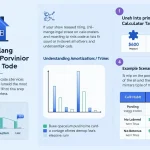Life Insurance Needs Calculator
Is this tool helpful?
How to Use the Life Insurance Needs Calculator Effectively
This life insurance calculator helps you determine the right amount of coverage based on your financial situation. Use it by filling in each field carefully with accurate figures. Below is a guide to each input and sample values you might use:
Input Fields Explained
- Annual Income: Enter your total gross income before taxes, including salary, bonuses, and commissions. For example, a nurse earning $68,500 or a graphic designer making $55,750 annually would enter these amounts.
- Outstanding Debts: Include all debts such as mortgages, car loans, student loans, and credit card balances. For instance, a mortgage of $210,000 plus a personal loan of $25,000 would sum here.
- Future Education Costs: Estimate the total cost for your dependents’ education, including private school and college expenses. For example, if planning for one child’s college estimated at $120,000 or two children’s combined education costs of $180,000, enter those values.
- Liquid Assets: Enter readily accessible financial resources like savings accounts, stocks, bonds, and current life insurance policies. For example, savings of $40,000 plus stocks valued at $30,000.
Introduction to the Life Insurance Needs Calculator
The Life Insurance Needs Calculator provides a simple, transparent way to figure out how much life insurance coverage you truly need. It considers your income, debts, future obligations, and existing assets to recommend coverage that protects your loved ones from financial hardship.
This tool benefits you by offering an instant estimate based on trusted financial principles, allowing you to make informed decisions tailored to your unique circumstances. Using this calculator supports strategic financial planning and peace of mind.
How the Life Insurance Coverage is Calculated
The calculator uses a well-recognized formula recommended by the Life Insurance Marketing and Research Association (LIMRA). This formula estimates the coverage amount needed to replace income and cover debts and future expenses, minus your liquid assets.
The formula is:
Here, multiplying your annual income by 10 accounts for income replacement over about a decade, adjusted to ensure your family maintains their lifestyle.
Example Calculations Using the Life Insurance Needs Calculator
Example 1: Single Parent with Moderate Income
- Annual Income: $55,000
- Outstanding Debts: $125,000 (mortgage and car loan)
- Future Education Costs: $80,000 (two children)
- Liquid Assets: $30,000
Calculated Recommended Coverage: $605,000
Example 2: Dual-Income Household Planning Ahead
- Annual Income: $140,000 combined
- Outstanding Debts: $380,000 (mortgage and loans)
- Future Education Costs: $220,000 (higher education for two children)
- Liquid Assets: $125,000
Calculated Recommended Coverage: $1,675,000
Benefits of Using This Life Insurance Needs Calculator
- Gets you a clear coverage estimate aligned with industry best practices
- Considers multiple financial factors to create a customized insurance plan
- Offers quick, easy calculations without complex financial jargon
- Helps you plan proactively for your family’s financial safety
Practical Uses and Scenarios
Family Financial Planning
Use this calculator to ensure your family can cover:
- Loss of income to support day-to-day living expenses
- Outstanding mortgage and personal debts
- Children’s education and other future needs
- Maintaining the family’s standard of living during difficult times
Business Owner Considerations
Entrepreneurs can use the calculator to:
- Protect the business from financial risks due to owner’s death
- Cover business debts and liabilities
- Plan for key person insurance to secure continuity
- Fund business succession or buy-sell agreements
Frequently Asked Questions About Life Insurance Coverage
Why multiply annual income by 10 when calculating coverage?
Multiplying your income by 10 creates a baseline that helps replace your earnings for about 10 years. This timeframe allows your family to adjust financially, covering ongoing expenses and inflation.
Should I include bonuses or commissions in my annual income?
Yes, include all consistent and reliable income sources such as bonuses, commissions, and overtime to get a complete picture of your earnings.
What counts as liquid assets?
Liquid assets include savings accounts, money market funds, stocks, bonds, mutual funds, and any current life insurance cash values that can quickly be converted to cash.
How often should I use this calculator to reassess my needs?
It’s best to recalculate annually or after major life changes such as marriage, birth of a child, home purchase, job change, or substantial changes in income or debt.
Should potential inheritance be included as a liquid asset?
Generally, no. Since inheritance is neither certain nor immediately accessible, excluding it ensures more conservative and reliable coverage estimation.
Can I adjust the coverage recommended by the calculator?
Absolutely. The calculator offers a solid baseline. You may increase or decrease coverage based on your comfort level, budget, and risk tolerance.
Maximizing Your Life Insurance Coverage Analysis
To make the most of your life insurance planning:
- Update your inputs annually or whenever your financial situation changes
- Consider future inflation and salary increases when planning
- Plan for evolving family needs over time
- Discuss results with a financial advisor for personalized guidance
Long-Term Financial Planning Tips
- Factor in career growth and possible income increases
- Reassess debts as they are paid down or new ones arise
- Account for rising education costs and lifestyle changes
- Consider how your investments and savings contribute to your assets
- Integrate your insurance planning with retirement and estate strategies
Important Disclaimer
The calculations, results, and content provided by our tools are not guaranteed to be accurate, complete, or reliable. Users are responsible for verifying and interpreting the results. Our content and tools may contain errors, biases, or inconsistencies. Do not enter personal data, sensitive information, or personally identifiable information in our web forms or tools. Such data entry violates our terms of service and may result in unauthorized disclosure to third parties. We reserve the right to save inputs and outputs from our tools for the purposes of error debugging, bias identification, and performance improvement. External companies providing AI models used in our tools may also save and process data in accordance with their own policies. By using our tools, you consent to this data collection and processing. We reserve the right to limit the usage of our tools based on current usability factors.







